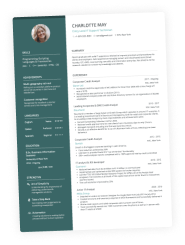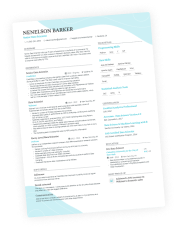So, should you mention a lack of experience in your cover letter?
Yes, you can—and often should—acknowledge a lack of experience in your cover letter. But do it strategically. By emphasizing transferable skills, demonstrating enthusiasm, and tailoring your message through company research, you can turn an experience gap into a unique strength.
Key takeaways
- Own your experience gap, but frame it in a growth-oriented light.
- Leverage transferable skills that apply to the role.
- Highlight relevant personal projects, volunteer work, or coursework.
- Showcase genuine interest in the industry and the company.
- Tailor the tone and content using insights from job listings and company research.
- Seek outside feedback to improve clarity and impact.
Drop your resume here or choose a file.
PDF & DOCX only. Max 2MB file size.
How to address a lack of experience in a cover letter
Avoiding the topic entirely can feel disingenuous. Hiring managers appreciate transparency and self-awareness. Instead of apologizing, acknowledge the gap briefly and pivot toward how you're actively closing it.
Example:
“While I haven’t held a formal marketing role, I’ve completed two digital marketing courses and led a successful campaign for a local nonprofit.”
This type of positioning frames you as a proactive learner—an attribute that often matters more than experience itself. It’s also exactly what to include in a cover letter when you want to emphasize your learning mindset.
Transferable skills: your hidden assets
If your experience doesn't match the job title, focus on skills that do. Think of communication, leadership, adaptability, or analytical thinking—qualities that transcend job titles.
Example for a career switch:
“Working in retail sharpened my ability to read customer needs quickly and communicate persuasively—skills that translate directly into client-facing roles in sales.”
Don’t just state your skills. Connect them to the employer’s needs to demonstrate relevance. This shows you understand the purpose of a cover letter—not to repeat your resume, but to connect your story to the employer’s goals.
Personalization starts with research
Before you begin writing, research the company’s mission, culture, and goals. Use that information to shape your tone, structure, and examples.
Where to look:
- The company’s website and “About” page
- Recent blog posts or press releases
- The job description—read it closely for keywords
- The hiring manager’s profile (LinkedIn can offer helpful context)
Why it matters:
Referencing a company’s values or goals shows that you’ve done your homework. It signals that your interest in the job is intentional, not generic.
“I was drawn to [Company Name]’s mission to expand access to financial education. As a volunteer budgeting coach, I’ve seen firsthand how impactful those tools can be—and I’m eager to help scale those efforts.”
Even without direct experience, aligning your background with the company’s vision can create a compelling connection.
Also, if you’ve been referred, consider how to name-drop in a cover letter to build credibility from the first sentence.
Passion over experience: why enthusiasm wins
When writing a cover letter without experience, passion becomes your selling point. If you’ve explored industry blogs, attended webinars, or completed side projects, include that.
For instance:
“I recently launched a social media campaign for a local nonprofit that increased engagement by 35%. That hands-on experience deepened my interest in digital marketing and confirmed my desire to grow professionally in this space.”
Use the letter to explain not just what you’ve done, but why you care. That kind of passion can be more persuasive than experience.
And if you’re creating an intern cover letter, energy and eagerness matter even more. Show that you’re ready to absorb everything the opportunity has to offer.
Don’t just admit your lack of experience—use it as leverage. Most hiring managers are bored stiff by candidates who “check all the boxes.” If you can show you're hungry, adaptable, and teachable, you're already more interesting than someone who’s just... qualified. Experience matters, sure—but attitude often wins the job.
What we think
Real-life evidence: use stories to prove potential
Your goal is to provide more than a claim—you need proof. Concrete examples from personal projects, volunteer roles, or coursework strengthen your narrative.
Prove your potential
Instead of writing:
“I’m a fast learner.”
Say:
“To develop my understanding of UX design, I completed a 12-week bootcamp and redesigned a nonprofit’s website, improving navigation and increasing time on site by 40%.”
Not only does this show growth, but it’s also exactly what a cover letter should say when you want to stand out despite a limited work history. In fact, your ability to craft a clear cover letter story matters more than your job title.
This approach works particularly well when writing a cover letter for an internal position and want to demonstrate how you’ve been preparing for new responsibilities.
Seek feedback and keep improving
One of the most overlooked steps in the writing process is geting feedback. Whether you use a friend, mentor, or a tool like Enhancv’s Online Cover Letter Builder, outside input can strengthen your messaging and help refine weak areas.
Want to make your draft even stronger?
Try:
- Reviewing a cover letter checklist.
- Asking someone in your target industry to review it.
- Using an AI tool like ChatGPT to find tone inconsistencies.
Each revision brings you closer to a compelling draft. You’ll learn how to write a cover letter that's clean, refined, and focused—even if you’re starting with little to no experience.
Final tips on how to address a lack of experience in a cover letter
When you don’t have a traditional background for a job, your cover letter is your chance to reframe your story.
Things to consider
| Tips to follow |
|---|
| Use the right structure: a strong cover letter header, a professional cover letter salutation, a concise opening, and a confident close. |
| Watch your cover letter spacing, choose the best font for cover letter readability, and follow a proven cover letter outline. Don’t forget the cover letter address—addressing the right person matters. |
| Wondering what a cover letter looks like? Short, well-formatted, and ideally between 250–400 words. So yes, the answer to how long my cover letter should be is: short enough to stay focused, long enough to show value. |
| Make sure your layout is easy to read. A good cover letter design supports clarity, not flashiness. You can even review some short cover letter examples to see how others have tackled it. |
| If you plan to send your letter digitally, remember to follow the best practices on how to email a cover letter—formatting, file naming, and tone all matter. |
| If the job posting asks for it, don’t forget to include your salary requirements in a cover letter format that’s both polite and professional. |
Conclusion: no experience doesn’t mean no value
Experience gaps don’t have to be roadblocks. If you're wondering whether to mention a lack of experience in your cover letter, the answer is yes—but do it with purpose.
Frame your story with:
- Honest self-awareness
- Clear transferable skills
- Research-backed personalization
- Passionate, relevant examples
Hiring managers don’t just hire resumes. They hire people. So show them the kind of person—and teammate—you are.
PRO TIP
Still asking, are cover letters necessary? For roles with heavy competition, a great cover letter could be the difference between being overlooked or landing an interview.




